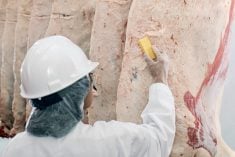A valid question arises when considering the latest supply and demand dynamics for the U.S. beef industry. Will it have enough beef to supply an expected increase in exports to its major market, Japan, and to emerging market China?
The U.S. has spent years developing export markets in virtually all corners of the globe, notably in Asia. It also depends heavily on exports to Canada and Mexico. The last thing it wants to do is to short any of these markets or the domestic market. But U.S. beef production is expected to increase only 1.5 per cent in 2020 versus 2019. Moreover, this increase will be mainly due to carcass weight increases. It doesn’t matter how heavy an animal is, it only produces one short plate, one set of short ribs, and so on. So some valued export items might be in tight supply.
Read Also

Scholarship winners, board elections and more beef industry news
Scholarship winners, board elections, Canadian Cattle Young Leader bios, and provincial Environmental Stewardship Award winners
U.S. beef exports the first 11 months of last year accounted for 14.1 per cent of total production and 11 per cent for muscle cuts only. This suggests that export markets are more valuable when selling byproduct items such as tongues and livers than they are for cuts. Beef demand in the U.S. was stellar last year, especially at the retail level. So packers will want to do everything they can to keep supplying their customers as long as beef keeps flying out of the grocery store this year.
This will occur as long as retail beef prices remain attractive to consumers. They have not been competitive with pork and chicken prices for some time. For example, USDA’s All Fresh retail beef price in December averaged US$5.96 per pound, while pork averaged US$3.81 per pound and chicken $1.92 per pound. These differentials will not matter as long as the U.S. economy remains solid. But any warnings about the onset of a recession will shake consumers’ confidence in the economy.
This in turn will cause them to adjust their protein purchases in a year that pork and chicken production will increase from 2019. Pork production is expected to be up 3.8 per cent while chicken is expected to be up 3.2 per cent. So the danger is real that the larger supplies of much cheaper protein might cut into domestic beef sales.
The supply side of the market, meanwhile, will be positive for cattle prices but suggests that total beef production will be up only slightly this year and will then decline in 2021. USDA’s annual cattle inventory report, released January 31, showed that U.S. herd expansion has come to an end after five years of expansion. The number of beef replacement heifers on January 1 was down 1.9 per cent on a year earlier and the number of beef cows was down 1.2 per cent. The total inventory was down 391,400 head or 0.6 per cent.
Another key figure was that the 2019 calf crop was estimated by USDA at 36.06 million head, 99.3 per cent of the 2018 crop. These animals are what will keep feedlots and packing plants supplied for at least the next 18 months. So both sectors might have to adjust to slightly smaller numbers.
Meanwhile, in reflection of this column’s name, it’s worth noting that the U.S. beef industry continues to produce more USDA-graded Prime beef as a result of years of genetic improvements. The per cent last year ranged from 6.86 per cent to 10.47 per cent weekly. The five-year average ranges from 4.35 per cent to 6.80 per cent, with the highest values in the fourth quarter. One danger is that recession might dampen demand for Prime, and that would penalize those producers who have been highly focused on producing Prime beef.
















